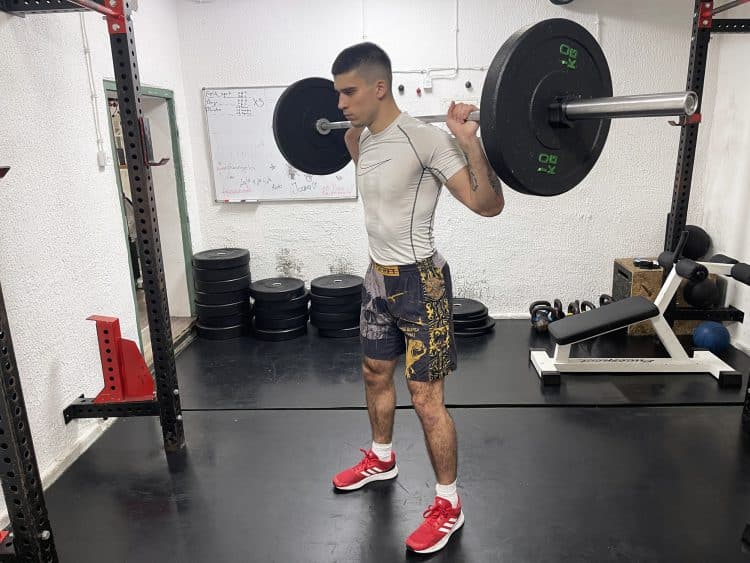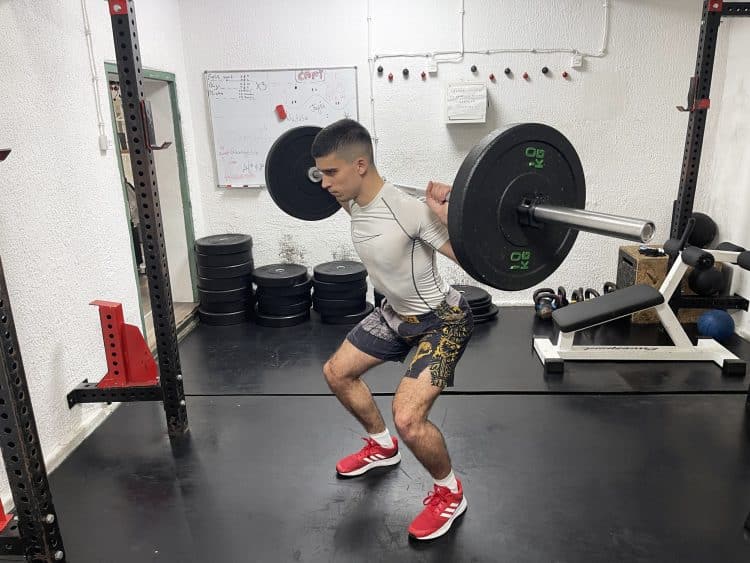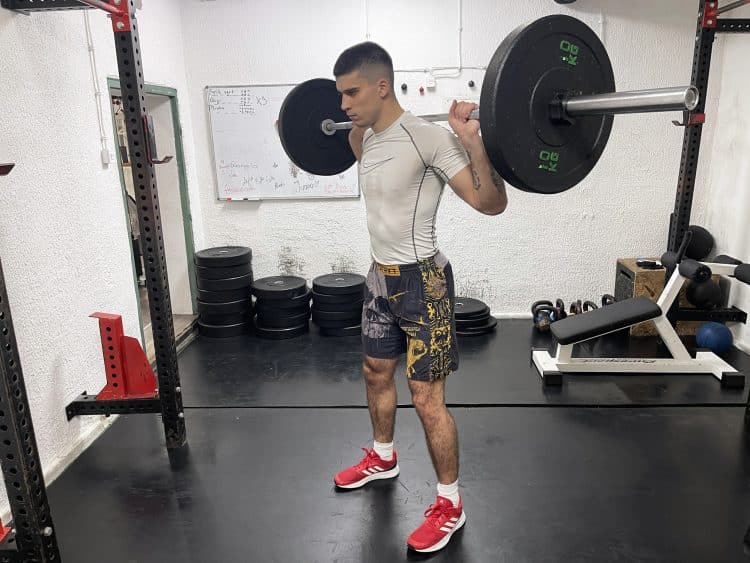Although quarter squats generally get a bad rap in the strength training community, I frequently incorporate quarter squats in my lower body workout routine and with my athlete clients for several reasons.
Quarter squats, popularly known as partials, are incredibly effective for building strength in the upper half of a squat’s range of motion. It can help with getting out of the sticking points during concentrics.
A study titled “The efficacy of incorporating partial squats in maximal strength training” suggests that partial squats may be beneficial for strength and power athletes during a strength-speed mesocycle while peaking for competition. (1)
I don’t generally recommend heavy partial squats for an average gym goer and fitness enthusiast. However, if you are cautious enough and execute it properly, it can be a potent tool in your exercise arsenal.
I took over 50 hours researching and creating the best possible quarter squat guide for you. Below, you will learn proper form and technique, the muscles worked, and the best tips, mistakes, and variations to implement in your lower body workout.
How To Do Quarter Squats
Here is how to execute quarter squats properly.
Level Up Your Fitness: Join our 💪 strong community in Fitness Volt Newsletter. Get daily inspiration, expert-backed workouts, nutrition tips, the latest in strength sports, and the support you need to reach your goals. Subscribe for free!
Step One — Assume the Starting Position
Load a barbell on the squat rack with an appropriate weight. Place the barbell on your upper back. Unrack it and step back. Assume the standing starting position with your feet shoulder-width apart. Your knees must be in line with your toes. Ensure your back is straight throughout the exercise.
Pro Tip: Before unracking the barbell, engage your core and take a deep breath to create an optimal bracing effect. This will provide extra stability and support for your back during the lift.
Step Two — Lower Into the Quarter Squat Position
Bend your ankles, knees, and hips to lower into a quarter squat. Ensure the eccentrics are slow and controlled. Hold the bottom position of the quarter squat for a second.
Pro Tip: As you lower into the quarter squat, think about sitting back in a chair. This helps with glute and hamstring engagement more effectively while reducing knee strain.
Step Three — Extend Your Ankles, Knees, and Hips
Reverse the motion to return to the starting position. Simultaneously extend your ankles, knees, and hips. Ensure your back is straight. Pause and squeeze at the isometric contraction point before proceeding with the next repetition.
Pro Tip: Focus on driving through your heels and engaging your core. This helps in maximizing power output and maintaining a stable, upright posture.
Watch Vanja Vukas perform the quarter squat correctly in the video below:
Muscles Worked During Quarter Squat
Here are the primary muscles worked during quarter squats:
- Quads
- Gluteus maximus
Also, here are the secondary muscles:
- Adductors
- Hamstrings
- Erector spinae
- Calves
- Core musculature
Best Tips For Performing Quarter Squats
Here is how to make the most of the quarter squats:
Proper Stance
Proper stance is vital for performing quarter squats. Stick to the shoulder-width stance and ensure your knees align with your toes. However, if you are an athlete, let’s say a volleyball or basketball player, there are a few tweaks to consider.
Narrowing your stance a bit to mimic the one from the game scenario may be more beneficial.
Spine Alignment
You must ensure your spine is neutral throughout the entire exercise. This means you must prevent rounding of your lumbar or thoracic spine continually. With the heavy barbell on your back, you must be extra cautious to ensure your spine is straight.
This is because the barbell will put tremendous pressure on your spine, and you must ensure it does not compress your spine.
Knee Position
Keeping your knees aligned with your toes will protect you against some of the most dangerous injuries, such as ACL tears.
Don’t let your knees cave inward or outward. This can put tremendous pressure on your collateral ligaments, which leads to strains and heavy injuries. Some of those injuries take over six months to heal, even with the most up-to-date scientific recovery practices and new technologies.
Core Engagement
Engaging your core is paramount to executing a quarter squat safely. When you activate your core, it stabilizes the spine. This leads to better whole-body stability, reducing the chance of potential injuries.
Level Up Your Fitness: Join our 💪 strong community in Fitness Volt Newsletter. Get daily inspiration, expert-backed workouts, nutrition tips, the latest in strength sports, and the support you need to reach your goals. Subscribe for free!
Brace your core at the beginning of the lift to create intra-abdominal pressure. This will fixate your spine. However, you must ensure a correct spine position before that. Bracing your core doesn’t make sense if you do it with a semi-rounded back.
Controlled Eccentric Movement
Lower into the quarter squat position slowly and with utmost control. This will prevent the majority of injuries. In addition to that, it will also increase time under tension (TUT), which is excellent for muscle hypertrophy. (2)
Additionally, slow and controlled movements are great for improving your mind-muscle connection. This is crucial for mastering form and technique while optimizing the energy you spend during the lift.
Proper Breathing
Proper breathing is crucial during quarter squats. Inhale during the lowering phase of the lift. During the ascending phase, quickly exhale to create intra-abdominal pressure.
Most Common Quarter Squat Mistakes
The most common squat mistakes to avoid include improper depth, lifting heels off the floor, rounding the back, uncontrolled movements, and not warming up.
Let’s tackle all these below now so you don’t injure yourself during quarter squats.
Improper Depth
Failing to achieve proper depth during quarter squats will hinder your progress. Since quarter squats already have a limited range of motion, you must hit adequate depth to achieve an appropriate intensity and muscle activation.
On the other hand, going too deep beats the purpose of this exercise. Using a box can help you gauge proper depth every time. I break down the form of box quarter squats under the variations section in case you experience problems estimating the proper depth.
Lifting Heels off the Floor
Lifting heels off the floor is generally due to compensating for the lack of ankle mobility (poor dorsiflexion), which results in compensatory bending in your hips. This relocates most of the pressure on your lumbar spine, significantly increasing injury risk.
Engage in daily ankle mobility exercises to address this problem. If, however, heavy damage to your ankle cartilage from frequent sprains, like in my case, makes this impractical, opt for elevating your heels instead. You can place your heels on a weight plate or squat wedge.
Rounding the Back
Rounding your back will put more pressure on your spine, increasing injury risk. You can prevent this by activating your core. Brace your core at the beginning of each set. Also, you can use a weightlifting belt.
This will help create the intra-abdominal pressure necessary to stabilize the spine. However, I don’t recommend using weightlifting belts all the time. You must still ensure your core muscles progress enough to handle heavy weight without using the belt.
Rapid, Uncontrolled Movements
Rapid and uncontrolled movement leads to injuries. Focus on performing the eccentric phase of the lift with the utmost control. Stabilize your body properly before the beginning of each set.
Not Warming Up
Not warming up properly increases injury risk. Make sure to raise your body’s core temperature by performing some form of light cardio for three to four minutes. Then, perform a series of dynamic stretches, followed by warm-up sets, to ensure proper muscle activation. You are also doing this to prepare your central nervous system (CNS) for what’s coming ahead.
Best Quarter Squat Variations
Here are the best quarter squat variations:
Box Quarter Squat
Box quarter squats will help you gauge proper squat depth.
Steps:
- Place a plyo box behind you that is as high as your quarter squat position.
- Load a barbell on the squat rack with an appropriate weight.
- Place the bar on your upper back.
- Unrack it and step back.
- Get into the starting position with a shoulder-width stance.
- Ensure your toes point out slightly.
- Your knees must be in line with your toes. Ensure your back is straight throughout the entire exercise.
- Lower until your butt touches the box.
- Reverse the motion to return to the starting position.
- Repeat for the desired reps.
Pro Tip: Touch the box with your glutes instead of sitting down completely. This ensures continuous muscle engagement and prevents you from losing tension at the bottom of the squat.
Front Quarter Squat
Front rack quarter squat is an excellent alternative to help you target your quads more.
Steps:
- Load the barbell on the squat rack.
- Place the bar in a front rack position.
- Step back to have enough space to perform the exercise safely.
- Lower into the quarter squat position and hold for one second.
- Reverse the motion to return to the starting position.
- Repeat for the desired reps.
Pro Tip: Actively push your elbows up and keep them in line with each other throughout the movement. This helps maintain a robust and upright torso and ensures the weight is balanced correctly and centered.
Wrapping Up
Quarter squat is an excellent tool for developing explosive strength and improving athletic performance. The tips I want you to remember while performing quarter squats include entering a proper stance, having proper spine alignment, aligning your knees with your toes, engaging your core, breathing properly, and ensuring controlled movement.
In addition to that, the most common mistakes you should avoid include improper depth, lifting your heels off the ground, rounding your back, uncontrolled movements, and not warming up. In the comments below, let me know how you implement quarter squats in your lower body workouts.
References
- Bazyler CD, Sato K, Wassinger CA, Lamont HS, Stone MH. The efficacy of incorporating partial squats in maximal strength training. J Strength Cond Res. 2014;28(11):3024-3032. doi:10.1519/JSC.0000000000000465
- Krzysztofik M, Wilk M, Wojdała G, Gołaś A. Maximizing Muscle Hypertrophy: A Systematic Review of Advanced Resistance Training Techniques and Methods. Int J Environ Res Public Health. 2019;16(24):4897. Published 2019 Dec 4. doi:10.3390/ijerph16244897
Relevant Articles:
- How to Build Mass Strength and Power with Eccentric Squats
- 34 Best Leg Exercises for Building Muscle and Strength
Interested in measuring your progress? Check out our strength standards for Squat.











